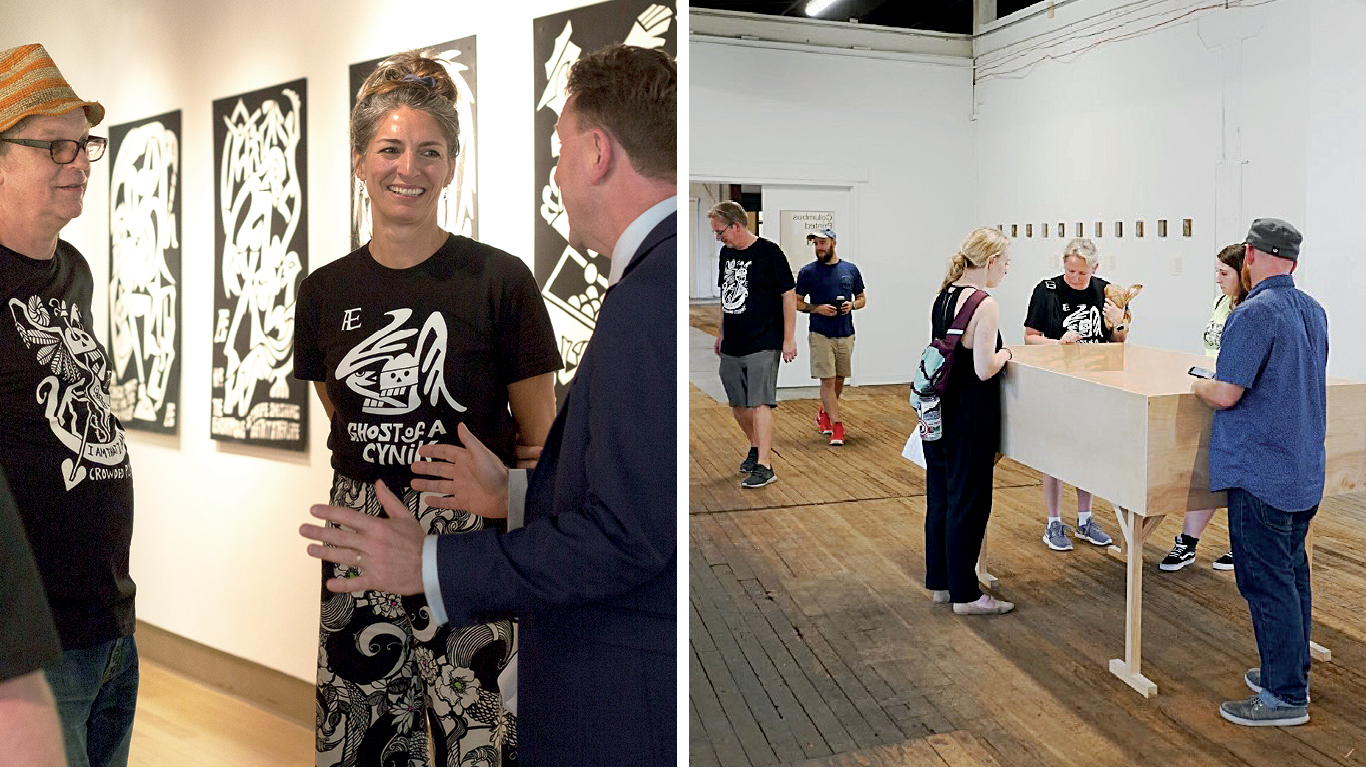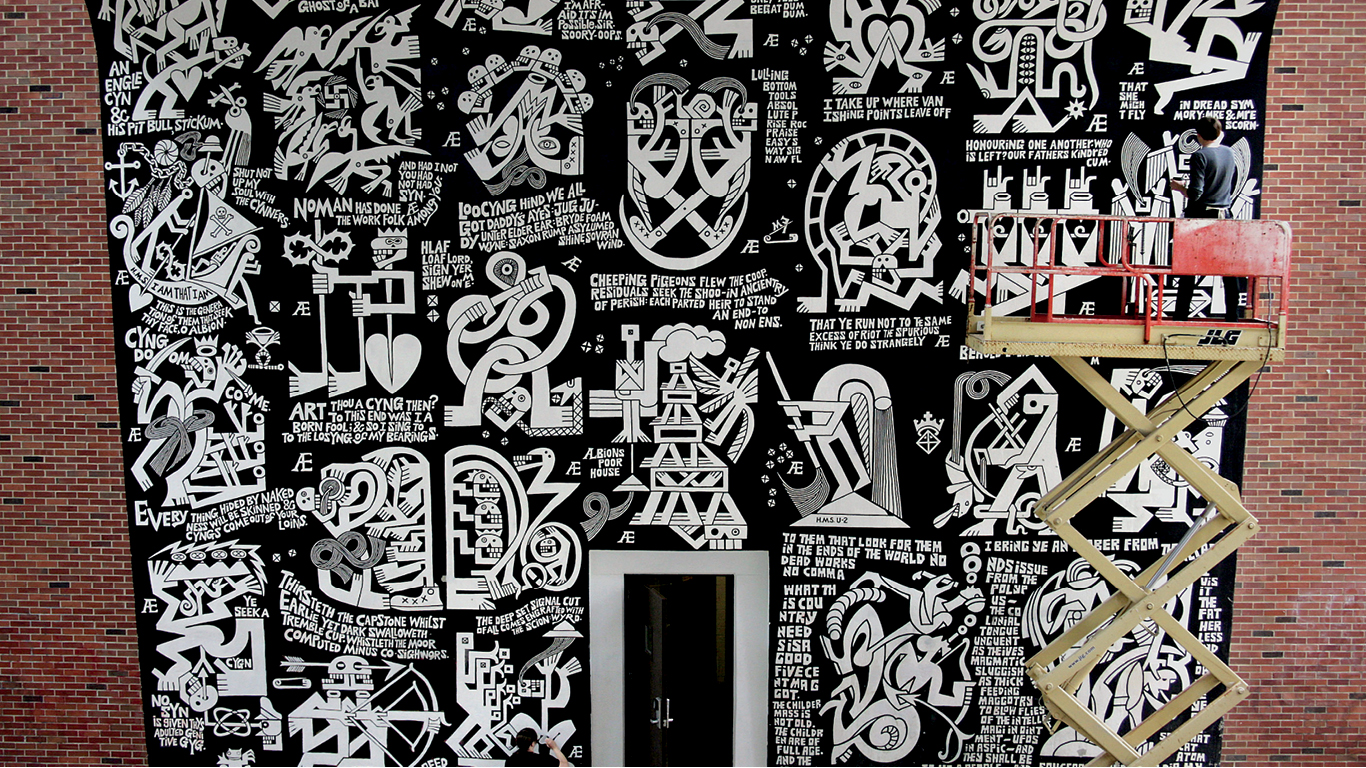Æthelred Eldridge (1930-2018)
Remembering the legendary artist and teacher
In winter 2018, the Ohio University community gathered to mourn the death and celebrate the life of one of its most legendary faculty members, Professor Emeritus of Painting + Drawing Æthelred Eldridge, who passed away on November 12, 2018. A recounting of his life and his impact on the College of Fine Arts, the University, and the region, follows.
Born James Edward Leonard Eldridge in Monroe, Michigan, in 1930, Eldridge was recognized at a young age and as he grew for not only his artistic talents but also for his athletic prowess. His combined talents earned him a full scholarship to the University of Michigan. A successful member of the Wolverine football team, he was drafted by the Detroit Lions but passed on that opportunity and instead joined the Navy to serve on the USS Hornet.
Eldridge joined the School of Art + Design faculty in 1958 at 28 years old and took the name “Æthelred” in place of his given name. Many remember him as complex, idiosyncratic, and sui generis: a singular artist with boundless creativity.
As an educator, Eldridge inspired and surprised his students with his famous, free-ranging classes. He would hold forth in what Area Chair and Professor of Sculpture + Expanded Practice Duane McDiarmid describes as “the old Oxford or Cambridge style, where you watch a genius in the front.” Students and faculty recall the range of orchestrated creative assignments he would give, including making a person out of bread, drawing eyes on the palms of gloves and placing them in unexpected locations in Athens.
Eldridge’s classes were often considered the easiest on campus—he frequently promised everyone enrolled an “A” grade. Yet, his classes were also noted for their emphasis on critical, original thinking, and for the professor’s fierceness. Eldridge would not hesitate to excoriate students who appeared distracted, arrived late, or didn’t seem properly committed to the lessons.
School of Art + Design Director Julie Dummermuth recalls the way Eldridge would always greet her when their paths crossed in Seigfred Hall: with a sweeping bow.
“I think part of that bow was to you as a person, part was to you as an artist,” Dummermuth says. “He knew what it was to be an artist and that the artist isn’t someone people bow to every day. I think he was saying that if no one else would acknowledge us, we should acknowledge each other.”
Area Chair and Professor of Painting + Drawing David LaPalombara remembers Eldridge as an aesthete.
“Everything he had was monastically spare,” LaPalombara says, “but I never met someone who was so constantly creative. He never wasted a moment of any day. I think everyone around him learned from the example he set as a singular creative person.”
Æthelred Eldridge’s son and student, Sebastian Eldridge, says teaching was central to the artist’s identity.
“It wasn’t just a passion for him, it was a calling. He couldn’t possibly not be teaching people.”
Eldridge stepped away from the lectern in 2014, ending 56 years of teaching in his enigmatic style.
Right: The School of Art + Design partnered with the Columbus Printed Arts Center to create an exhibition of printed matter by Æthelred Eldridge in fall 2019. Photo courtesy of CPAC
Besides teaching and his avant-garde artwork, Eldridge achieved fame for his storied personal life.
Artist Alexandra Eldridge, his former wife—Eldridge would ultimately be married four times—and Eldridge founded a site they named Golgonooza, the Church of William Blake, named after Blake’s own fictional City of Imagination. Eldridge became licensed to marry couples and baptize children at the church. He held special events and gave sermons every Sunday for nearly a decade. Golgonooza, located on Eldridge’s land just north of Athens in Millfield, became a destination for a wide array of counter-cultural types, including celebrities such as Maharishi Mahesh Yogi and the Grateful Dead. Eldridge worked much of the land himself, digging out ponds and constructing buildings by hand. He lived most of his life there without running water or electricity.
Eldridge eschewed self-promotion, often saying, “I am not a promoter, ringmaster, or chronicler of myself.” So, he's remembered through stories from those who worked and studied with him.
As a young faculty member, McDiarmid went to Golgonooza and attempted to document Eldridge in action.
“He threw me off the property,” he laughs. “He appreciated my attention, but he needed to throw me off so I could go home and do my own work, because that was the work I should be doing.”
Eldridge’s multidisciplinary approach to making art and his lack of interest in self-promotion epitomizes his overall philosophy. Early in his career he turned away from promising relationships with art galleries in New York and Detroit and instead focused on teaching performances, architectural constructions, and community building at Golgonooza. His work is in books, zines, drawings, prints, paintings, murals, and even films, placing him squarely ahead of his time, says McDiarmid.
“This was a guy who got to happenings before there were happenings. He got to zines before there were zines. He got to the idea of a unified art and life balance before people were talking about that,” says McDiarmid. “He got to regionalism and Appalachian craft early. There are so many places he got to early, with so much integrity.”
Over the past 10 years, Saxon and Sebastian Eldridge have been digitally preserving their father’s booklets, paintings, carvings, and other works. In fall 2019, the University and the College of Fine Arts honored Eldridge’s tenure through events, exhibitions, and participatory happenings. Proceeds from sales of T-shirts featuring his artwork support student research, travel, and other professional development opportunities in the College.
Æthelred Eldridge—artist, maker, father, performer—lives on, and future collaborations between OHIO and the Eldridge family will keep his legacy alive.

